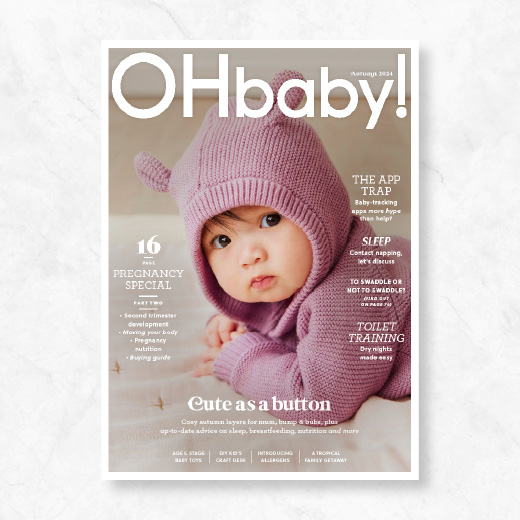7 common skin issues in babies and toddlers

General practitioner and urgent care doctor, Dr Isabelle Duck talks us through seven common skin conditions in babies and young children.
There is no denying that few things are as delicate, as soft and as sensitive as a baby's skin. It is no wonder that although rashes and other skin conditions in babies and children are extremely common, they cause much anxiety among parents and caregivers. This article aims to provide information about some of the common childhood disorders of the skin.
Most children will experience a skin rash at some point within their first few years of life. When discussing skin rashes, it is important to remember that the skin is an organ, just like the kidney or the heart. And, as with any other organ, it has many vital functions. These functions include temperature regulation, sun protection, the prevention of infection and moisture retention.
First, some anatomy. The skin is made up of three layers: the epidermis, which is the outer layer; followed by the dermis, which is the thickest layer; and finally, a layer of subcutaneous tissue, which contains fat and connective tissue. Within these layers are several essential structures including sweat glands, nerves, blood vessels and hair follicles.
"If your child has a rash or any disorder of the skin, it is crucial that they are taken to the doctor. There is no substitute for a face to face examination by a trained medical professional."
If your child has a rash or any disorder of the skin, it is crucial that they are taken to the doctor. There is no substitute for a face to face examination by a trained medical professional. In addition to an examination, the doctor will ask questions about your child's rash. Things to consider include how long the rash has been present; whether or not the rash appears itchy; whether your child has a fever or is lethargic; and whether the rash is confined to one area, or is more generalised. It is also important to discuss any relevant family history of skin conditions. You may wish to take photos of your child's rash as they can evolve very quickly. These photos can also be shown to the doctor.
Below is an outline of a few of the skin conditions affecting babies and young children. Please note that this list is by no means exhaustive.
ECZEMA (ATOPIC DERMATITIS)
Eczema is extremely common in babies and young children. It is a condition which affects the epidermis of the skin. It has been known for nearly 20 years now, that it occurs when the building blocks of the skin have a defect. The surface layer should be completely impenetrable. This defect however causes gaps in the mortar between the bricks. These gaps cause the skin to lose moisture and to become dry and itchy. This affects babies more because their skin is already more prone to moisture loss. There are often patches of redness on the skin. In babies, it can present anywhere but is most commonly on the face. As the baby grows into a toddler, the distribution may change, moving to the limbs, particularly to the creases of the skin. There may be a family history of allergic conditions such as asthma or hay fever. If you think that your child may have eczema it's best to seek medical advice from a health professional who has expertise in this area. If your child is diagnosed with eczema, your doctor will advise on how best to manage it. The main thing to remember is that eczema is a chronic medical condition which requires ongoing management to prevent flares. The main aim of treatment is to retain moisture within the skin and to reduce inflammation. Emollients (moisturisers) are important to stop the skin from drying out and should be free from fragrances and food proteins. Your doctor or pharmacist can advise which is the best for your child. Recommendations are to use these emollients even when the eczema is well controlled. It is also important to discuss the best way to clean your child's skin, as soap will dry the skin and hence worsen eczema. Steroid creams are often needed to manage the inflammation in eczema-affected skin. It is important to understand that there are different levels of steroid creams and the lower levels are safe to use. This is supported by quality long term data. Hydrocortisone 1% is highly unlikely to harm your baby. Without the help of this anti-inflammatory it is often impossible to get full control of the itch.
URTICARIA
Urticaria (otherwise known as 'hives') is another common skin rash in children. This can appear very quickly and is caused by an allergy or a viral illness. Sometimes no cause can be found. It presents as raised red bumps that are often paler at the centre due to swelling. The patches are usually of varying size. Urticaria are itchy due to the chemical histamine being released under the skin. On occasion the hives co-exist with other symptoms such as swelling around the mouth and eyes; wheeze; or gastro-intestinal symptoms (such as abdominal pain, vomiting or diarrhoea). If these have occurred quickly then a child may be having a serious allergic reaction and they must be checked urgently by a health professional - whether that is by a doctor or a paramedic. If no food has been consumed in the hour prior to the rash it is very unlikely to be related to a food allergy. A child must never be given a food without first checking with a caregiver.
IMPETIGO (SCHOOL SORES)
Impetigo is a common skin infection which is caused by a bacteria. Typically, it presents as honey-coloured crusts to the skin. There may also be blisters, vesicles, and scabs and it's highly contagious. It often starts in areas of the skin which are compromised, such as cuts, scrapes or skin which is affected by eczema. The key feature of impetigo is that it starts spreading outside the initial affected area. Treatment sometimes includes topical creams, but if there are more than a couple of spots then oral antibiotics are often required. To prevent the spread, it's important to maintain good hand hygiene, not share towels and to cut your child's fingernails short. Dressings can be applied to the lesions to prevent spread.
TINEA (RINGWORM)
This rash typically presents as a flaky ring-like lesion which is very red around the rim. It can affect any part of the skin, including the scalp, where it can occasionally cause hair loss. The term 'ringworm' is a misnomer. This condition is in fact caused by a fungus. It too can be very itchy, and can be contagious. It can spread to close contacts through sharing bedding and towels, or through use of public shower rooms. Sometimes transmission can occur through pets. Your doctor or pharmacist can advise on how best to treat tinea, but most mild cases will settle with an antifungal cream.
MOLLUSCUM CONTAGIOSUM
Molluscum contagiosum is a common skin condition in young children which is caused by a virus. It presents as one or more round, raised and skin-coloured spots. Often these spots contain a central depression. Molluscum contagiosum is a harmless condition which is usually spread via close contact with an infected person. Usually these lesions settle on their own within a few months and do not require treatment.
WARTS
As with molluscum contagiosum, warts are caused by a virus. In this case, the virus is called human papillomavirus, or HPV, which causes overgrowth and thickening of the epithelium of the skin. Warts can occur on any area of the skin but commonly on the hands and the feet. Although warts usually resolve on their own, they can sometimes become large and painful. Treatment options can be discussed with your doctor and include skin applications or, in older children, cryotherapy – a treatment which freezes and kills the virus.
SUNBURN
Sunburn is an inflammatory condition of the skin caused by excessive exposure to sunlight. It is caused by ultraviolent radiation from the sun which can damage all three layers of the skin. Sunburn can cause reddening of the skin, and, in more serious cases, blistering and lethargy. Cover your child's skin with loose clothing, encourage them to wear a hat, a pair of sunglasses and apply a high factor sunscreen (such as SPF 50). Sunscreen should be applied every 2 hours, and to all areas of exposed skin. This includes to the feet and ears-areas which often get forgotten. Sunscreen needs to be reapplied if your child goes swimming. You should avoid using sunscreen in babies under the age of 6 months, so best to keep them out of the sun. If your child does get burnt, it is important to seek medical advice. Kiwi kids love the outdoors – beaches, barbecues and swimming are part of our culture. Whilst it is important for children to keep active and enjoy our beautiful natural environment, it is imperative that their skin be protected from New Zealand's harsh sun. New Zealand has the highest rate of malignant melanoma (a type of skin cancer) in the world. By protecting your child's skin from a young age, you are reducing their risk of melanoma in later life.
All children will experience some type of skin complaint during their lives. Most skin conditions are harmless and self-limiting and even the long-term skin conditions, such as eczema, can be well controlled under the guidance from an experienced medical professional. As well as seeing the doctor when a rash appears, it is important to protect your child's skin from the sun. A lot of us can relate to how difficult it is running after a toddler on the beach trying to apply sunscreen or a hat, but remember that a single episode of sunburn can increase your child's risk of developing skin cancer in later life. Your efforts are not in vain.
References available on request. Thanks to Dr Rebekah Thompson for her contribution to this article. Dr Thompson is a general practitioner with postgraduate training in allergic conditions, and director of the Northern Allergy clinic. Find her at northernallergyclinic.co.nz.
Dr Isabelle Duck is a general practitioner and the clinical director of Silverdale Medical Urgent Care in Auckland. She lives in Hobsonville with her husband – a lecturer, and their 6-year-old daughter, Lauren.

AS FEATURED IN ISSUE 65 OF OHbaby! MAGAZINE. CHECK OUT OTHER ARTICLES IN THIS ISSUE BELOW

















